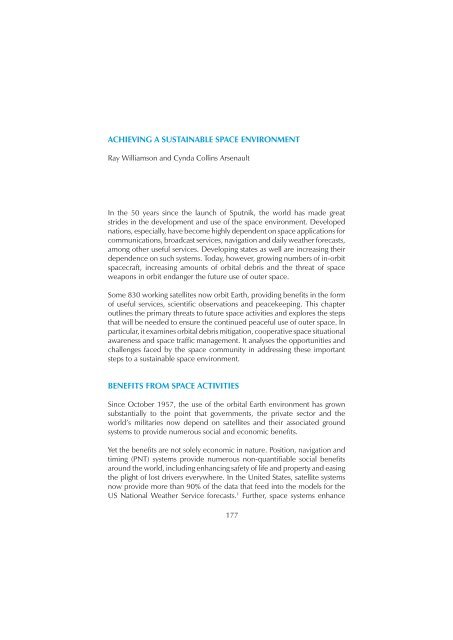Security in Space The Next Generation - UNIDIR
Security in Space The Next Generation - UNIDIR
Security in Space The Next Generation - UNIDIR
Create successful ePaper yourself
Turn your PDF publications into a flip-book with our unique Google optimized e-Paper software.
ACHIEVING A SUSTAINABLE SPACE ENVIRONMENT<br />
Ray Williamson and Cynda Coll<strong>in</strong>s Arsenault<br />
In the 50 years s<strong>in</strong>ce the launch of Sputnik, the world has made great<br />
strides <strong>in</strong> the development and use of the space environment. Developed<br />
nations, especially, have become highly dependent on space applications for<br />
communications, broadcast services, navigation and daily weather forecasts,<br />
among other useful services. Develop<strong>in</strong>g states as well are <strong>in</strong>creas<strong>in</strong>g their<br />
dependence on such systems. Today, however, grow<strong>in</strong>g numbers of <strong>in</strong>-orbit<br />
spacecraft, <strong>in</strong>creas<strong>in</strong>g amounts of orbital debris and the threat of space<br />
weapons <strong>in</strong> orbit endanger the future use of outer space.<br />
Some 830 work<strong>in</strong>g satellites now orbit Earth, provid<strong>in</strong>g benefi ts <strong>in</strong> the form<br />
of useful services, scientifi c observations and peacekeep<strong>in</strong>g. This chapter<br />
outl<strong>in</strong>es the primary threats to future space activities and explores the steps<br />
that will be needed to ensure the cont<strong>in</strong>ued peaceful use of outer space. In<br />
particular, it exam<strong>in</strong>es orbital debris mitigation, cooperative space situational<br />
awareness and space traffi c management. It analyses the opportunities and<br />
challenges faced by the space community <strong>in</strong> address<strong>in</strong>g these important<br />
steps to a susta<strong>in</strong>able space environment.<br />
BENEFITS FROM SPACE ACTIVITIES<br />
S<strong>in</strong>ce October 1957, the use of the orbital Earth environment has grown<br />
substantially to the po<strong>in</strong>t that governments, the private sector and the<br />
world’s militaries now depend on satellites and their associated ground<br />
systems to provide numerous social and economic benefi ts.<br />
Yet the benefi ts are not solely economic <strong>in</strong> nature. Position, navigation and<br />
tim<strong>in</strong>g (PNT) systems provide numerous non-quantifi able social benefi ts<br />
around the world, <strong>in</strong>clud<strong>in</strong>g enhanc<strong>in</strong>g safety of life and property and eas<strong>in</strong>g<br />
the plight of lost drivers everywhere. In the United States, satellite systems<br />
now provide more than 90% of the data that feed <strong>in</strong>to the models for the<br />
US National Weather Service forecasts. 1 Further, space systems enhance<br />
177








